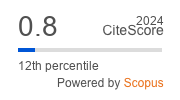
The Journal Materials of Electronics Engineering has been published since 1998 in Russian, contains new articles and reviews and is one of the major scientific journals in physics, materials science and the development of science consuming mirco- and nanoelectronics technologies. Its pages always provide scientific results and topical reviews of leading scientific schools of Russia and other states.
Members of its Editorial Board are Russia’s leading experts in respective fields and leading foreign scientists. This provides for a high level and sufficient objectiveness in the selection of published works on physical and chemical issues of advanced materials science. All the articles pass careful examination and then approved for publication at Editorial Board meetings.
At a decision of the Higher Attestation Committee of the Ministry of Education of the Russian Federation (http://vak.ed.gov.ru/87), the magazine has been included into the List of periodical and Scientific Publications issued in the Russian Federation that are recommended for publishing the main results of Dr.Sci. theses.
The journal is included into the full-text database eLibrary.ru (http://elibrary.ru/title_about.asp?id=7815), the Russian Index of Scientific References, the Reference Journal and the VINITI Database. Since 2013 the articles published in the magazine receive DOI.
Part of the articles published in the journal are translated in English by Pleiades Publishing, Ltd. and published on an annual basis in Russian Microelectronics, No. 8 (http://www.maik.ru/contents/micelec/micelec8_14v43cont.htm).
Russian Microelectronics is abstracted and/or indexed in SCOPUS, INSPEC, Chemical Abstracts Service (CAS), Google Scholar, EBSCO, Academic OneFile, Academic Search, CSA Environmental Sciences, Current Contents Collections / Electronics & Telecommunications Collection, EI-Compendex, Gale, INIS Atomindex, OCLC, SCImago, Summon by ProQuest, Thomson Reuters (ISI).
The Journal “Izvestiya vuzov. Materialy elektronnoi tekhniki” ("Materials of Electronics Engineering") is registered in Federal Service for Supervision in the Sphere of Mass Communications (PI number FS 77-59522 of 10.23.2014), the previous certificate number 016108 from 15.05.1997.
Index in catalogues Russian Press (http://www.pressa-rf.ru/cat/1/edition/y_e47215/) and UralPress: 47215 (http://www.ural-press.ru/catalog/).





































